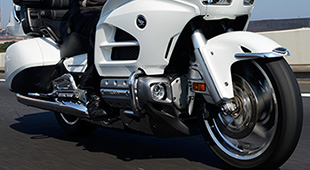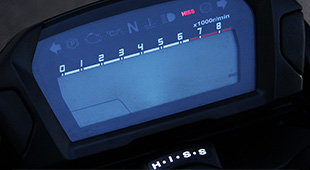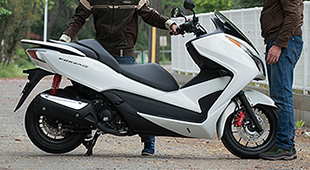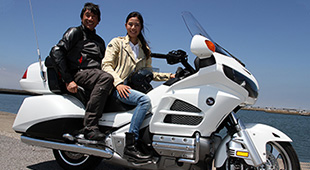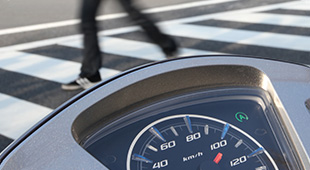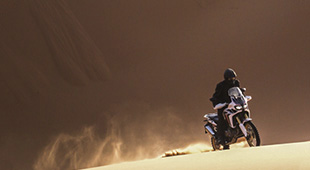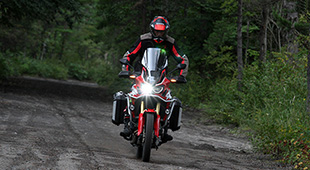Tech Views — Vol.1 Dual Clutch Transmission
NC700S (Dual Clutch Transmission)

NC700S (Dual Clutch Transmission)
The High-Tech Naked Model.
The NC700S is a unique sports bike having its fuel tank positioned under its seat and a 21-liter luggage space conveniently located directly in front of the seat, which is normally occupied by the fuel tank. Its outward design concept, equipped with the parallel-twin engine that has gained lots of low- and high-speed torque, is in fact a new concept.
The NC700S comes in several versions in addition to its basic manual transmission model. One of these includes the Dual Clutch Transmission, which electronically controls clutch and gear shifting operations. Totally distinct from the automatic transmission systems found in scooters, the Dual Clutch Transmission features a fairly standard six-speed transmission, but with two compact, independently actuated packs of clutch plates, one for gears 1, 3 and 5, and one for gears 2, 4 and 6. Owing to limited space, there are few examples of this sort of clutch in the world of motorcycles, and such a unique approach indeed seems to be typical of Honda.
Dual Clutch Transmissions are not uncommon to cars, especially premium class sports models. They can smoothly precisely change gears more quickly than can be accomplished by manipulating a shift lever. Further, as with the paddle shifting that originated with the F1 racers, another advantage of the Dual Clutch Transmission is that it enables riders to better concentrate on the riding by automating or using convenient switches to enable clutch or gear shifting operations.
One immediately noticeable feature of a Dual Clutch Transmission model's appearance is the has no clutch lever or shift pedal. Also, no particular rules apply to engine starting, etc., with Dual Clutch Transmission models. Since the transmission always shifts back to the neutral position when the ignition key is turned OFF, only a touch of the starter button is required. Preparation for getting on the move is completed by shifting the right-side selector switch from N (Neutral) to D (Drive). After this, the motorcycle begins to roll as soon as the throttle grip is turned.
What impressed me most was its exquisite clutch operation. Although I've ridden bikes with clutches for over 30 years, the Dual Clutch Transmission effortlessly provides the ideal start that I have always tried to achieve, and does so first time, every time. Upshifts are usually done at 2,500 rpms in town, though this depends on how much throttle is used. At the instant the gears change, there isn't so much as the slightest interruption in drive power felt. Even when compared to the manual version of the NC700S, shifting speed is equal to or faster than can be accomplished by hand and foot. Of course, hasty shifting of a manual transmission can result in missed shifts and grinding gears, but this never occurs with the Dual Clutch Transmission. This is really superb.

Turning across traffic at a signal, after waiting and letting oncoming vehicles pass, I start by simply turning the throttle. This frees up room in my mind and, by extension, frees me of any stress.
Even when riding in automatic mode, the NC's 17-inch tires front and rear and its riding position are all very much like a sports bike. The sorts of sensations I normally get from riding a scooter simply do not come to my mind. The Dual Clutch Transmission automatically shifts down a gear when I crank open the throttle for a stronger burst of acceleration in automatic mode, and shifts up naturally when rolling off the throttle and beginning to cruise.
My feeling was that the throttle and shifting operations I felt during this period was excellent, even from the perspective of my own many years of riding experience. This seemed to be sure proof that the ECU is well programmed. If this control resulted in any sort of frustrations, then the Dual Clutch Transmission for motorcycles would likely not have been born into this world. Freed from clutch operations around town, my left hand no longer gets fatigued. On the contrary, since I can direct my attention toward the front brake lever at my right hand, the touch of the brake's master cylinder and operating feel feed back to me through my fingertips, sharpening my focus.
When exploring the Dual Clutch Transmission's potential on a winding mountain road, I find I'm better able to enjoy the structure of the ride, from setting up my lines to checking the timing of my braking and corner entry, judging where to bank deepest and how far to open the throttle to pull up and out of the turn. Total concentration.
Moreover, there seems to be no need to switch between MT (Manual) and AT (Automatic) modes, since the gears can be shifted at any time using the "+" and "−" switches on the left switch module while leaving it in AT mode. Whether changing my own gears to ride more aggressively or using the engine brake, I feel I can enjoy the style of riding I like with a sense of complete unity with the machine. Shifting operation is almost telepathic, and completed the instant the switch is pressed.
The Dual Clutch Transmission has given me an entirely new experience and big advantage that could only be made possible with Honda. In the end, I finally came to understand that this combination of the NC700S and its Dual Clutch Transmission is a reliable and powerful weapon.

Both the NC700X (L) and the NC700S (R) are available in Dual Clutch Transmission versions, and differ only slightly in appearance from their manual transmission counterparts.
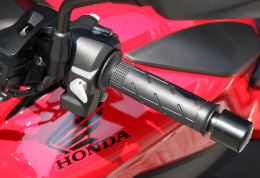
Instead of a clutch lever, the Dual Clutch Transmission models feature a pair of shifting switches and a parking brake lever mounted on the left handlebar.
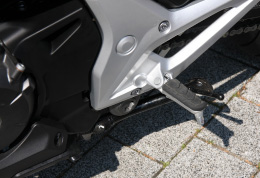
The Dual Clutch Transmission does not have a shift pedal. Users note that no longer having a shift pedal scuffing up their shoes is also an advantage of the system.
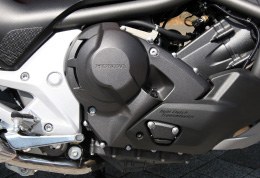
For mechanical reasons, the right-side engine cover design is slightly more bulky than the MT models.
TRANSMISSION TECHNOLOGIES - DUAL CLUTCH TRANSMISSION -
Honda has developed a motorcycle transmission with automated clutch and shift operation that delivers the same riding enjoyment as a manual transmission.

